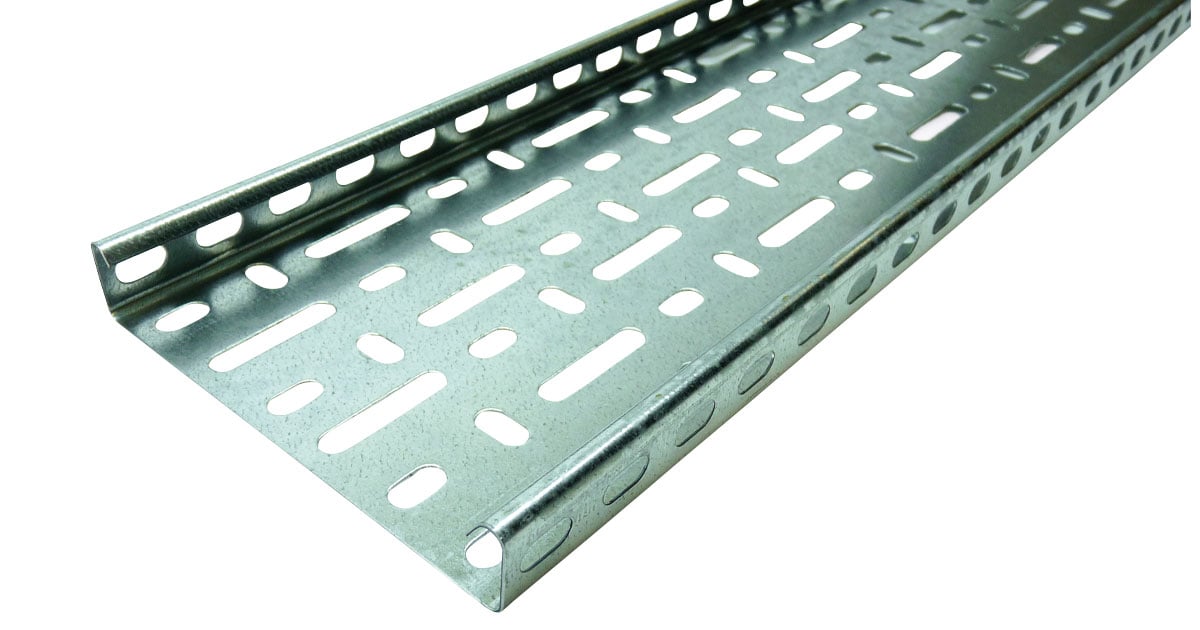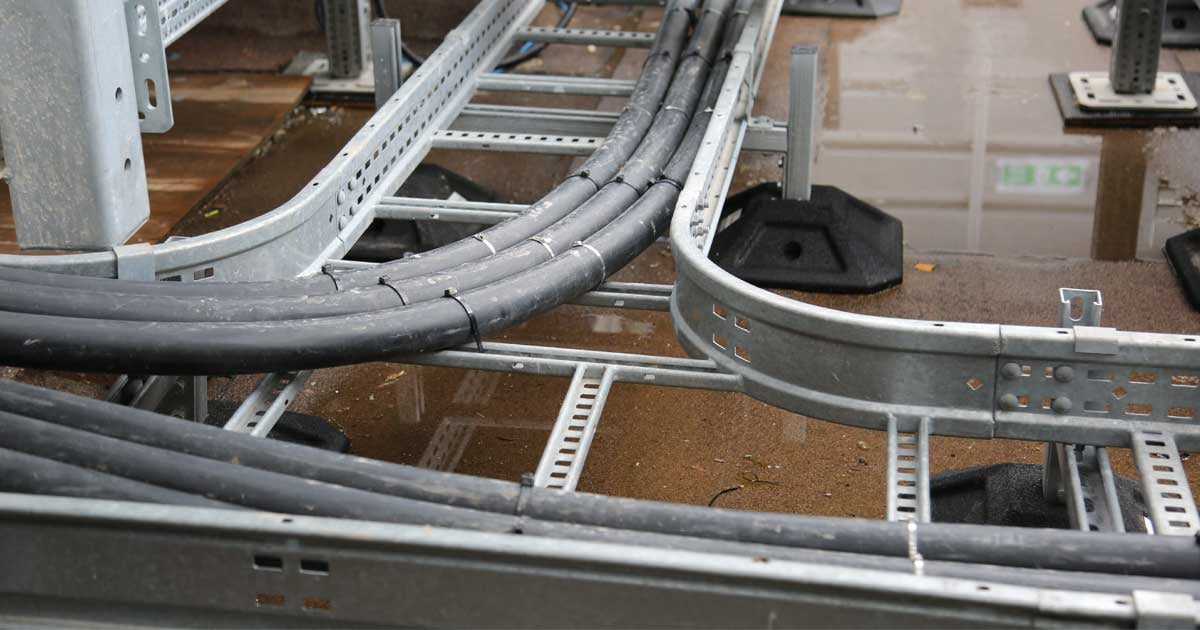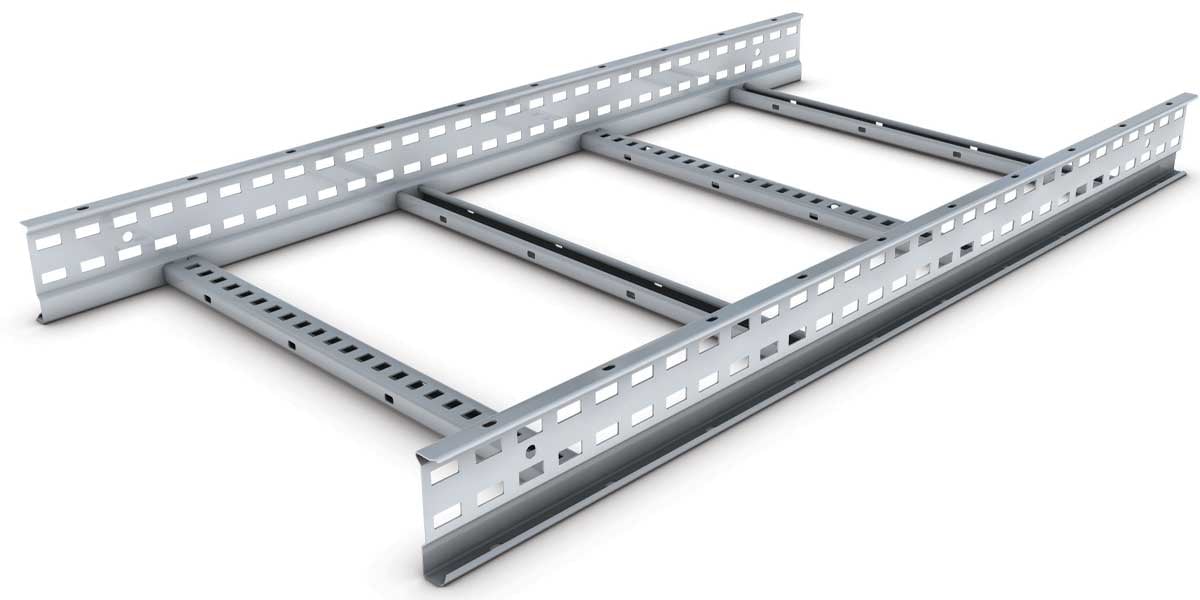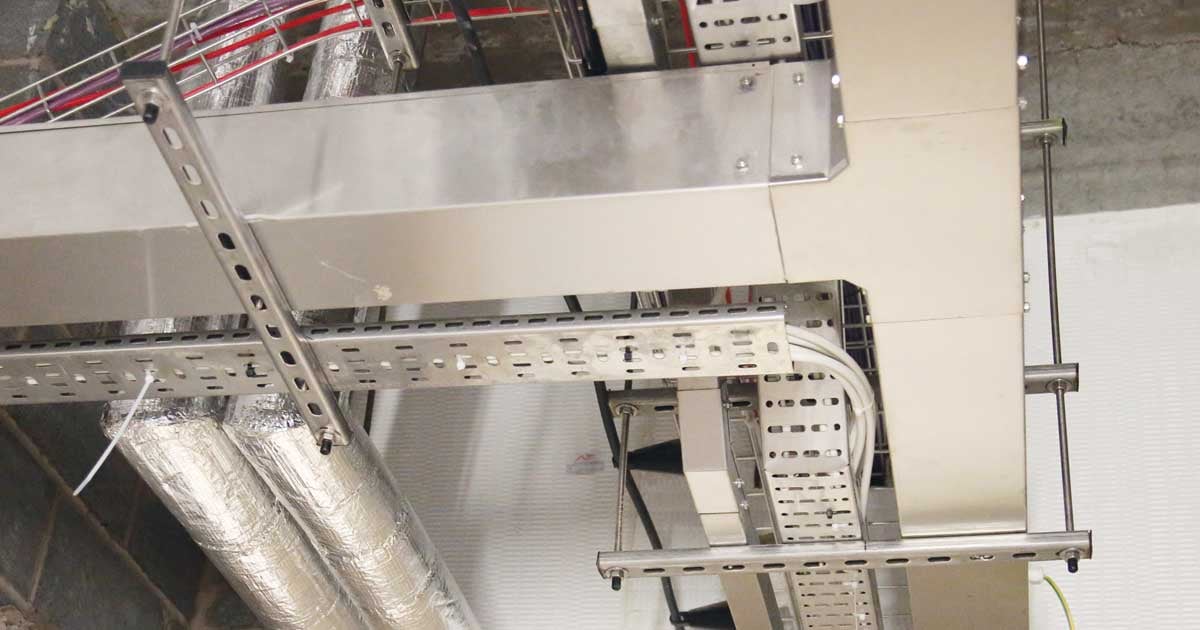As an M&E contractor, you’re probably aware of the importance of cable containment and how often it is used. It’s a vital element of services as it’s used to support cables, make cable management easier, appear more aesthetically pleasing, and for power distribution. But there are a few different types of cable containment, so you may be a bit unsure as to which ones are more applicable to your projects, and when to use each type.
This article will discuss the four most common types: cable tray, cable basket, cable ladder, and cable trunking. While this list is not exhaustive, these are the ones you’ll likely run into most frequently in electrical installations.
- What is cable tray?
- Why and when would I select cable tray?
- What options of cable tray are available?
- What is cable basket?
- Why and when would I select cable basket?
- What options of cable basket are available?
- What is cable ladder?
- Why and when would I select cable ladder?
- What options of cable ladder are available?
- What is cable trunking?
- Why and when would I select cable trunking?
- What options of cable trunking are available?
- Conclusion
What is cable tray?
Cable tray is a support system for cable installations. It is typically not covered on top (although it can be) and has a regular slot pattern on the flat, wide bottom and sides which allows for easy positioning of cables and fastening of cable ties. The bottom coverage reduces electromagnetic interference, and the holes enable water drainage and ventilation. The sides are slightly raised to keep the cable from slipping off. Essentially, it is a ‘bridge’ that holds cable across a distance. Trays also provide additional support and prevent cables from drooping and any consequential damage to the circuit’s performance.
Why and when would I select cable tray?
Cable tray is used commonly to organise smaller cables and is suitable for light electrical and instrumentation cables and tubing. It’s a great solution primarily for running high quantities of power cables or control cables overhead or under-floor. It’s flexible, easy to adjust, and a great cost-effective option for cable containment that is also easy on the eye.
What options of cable tray are available?
These are available in 3-metre lengths in either light, medium, or heavy-duty gauges and are usually pre or post-galvanised – although other finishes, like powder-coating and stainless steel, are sometimes used where specific installation environments may require a more corrosion-resistant material.
A variety of fittings is available, such as equal tees, flexible risers, bends at 45°, and at 90° depending on the specification and layout of the room, etc.
Light-duty tray has 12mm and/or 18mm deep non-return flanges in widths between 50mm and 75mm, while medium-duty cable tray, the most popular choice, has 25mm deep return flanges and comes in widths between 50mm and 600mm.
Heavy-duty cable tray has 50mm deep return flanges and comes in widths between 75mm to 750mm.

What is cable basket?
Cable basket is a type of cable containment made of steel wires welded together, forming a wire mesh, akin to basket. It, of course, supports and suspends cables and wiring. The open design enhances air circulation and prevents heat and dust build-up as there is less surface area for it to accumulate. Sometimes, large power cables set within the basket may need support blocks to solve the spacing issues between conductors and stop overheating of the basket’s wires.

Why and when would I select cable basket?
Cable baskets are great solutions for routing and supporting numerous cable runs and when there is a large number of smaller cables involved. Because the system is ventilated, they’re also appropriate beneath desks, elevated floors, or hanging tray systems.
One of its benefits, particularly over cable tray, is its ease and speed of installation. They can easily be clipped together and don’t require gutter bolts, roofing, bends, tees, or any separate component; as opposed to cable tray which needs to be bolted together with gutter bolts. All you need are couplers, clips, and bolt croppers. Say you wanted to go around a 90° bend; you’d just have to snip out a V in a wire and bend it. You’re not forced to stick to an angle – you can make the bend at whatever angle you need. Any change of direction is very easily made, making the routing of installation much more flexible. Couplers are used for lengths, and clips for making tees and bends.
On top of this, if you need to drop cables down, for example, if you had a run and needed to drop cables down each metre, you can easily push through the gaps at the bottom of the basket. They’re also very lightweight, and therefore ideal for one-man installation, but still have good load-bearing characteristics.
You can assemble cable baskets for intersections, horizontal sections, mounting braces, and hardware.
They come in different finishes for different applications but are almost always used indoors. The Rapide system is ideal for trapeze type indoor installations (due to its electrogalvanised finish).
What options of cable basket are available?
One of the most well-known brands Pemsa Rejiband, which comes in steel with a silver zinc-plated finish suitable for indoor, non-corrosive environments. Other finishes are available if required, such as stainless steel, hot-dip galvanised, high resistance coating for extra corrosion resistance, electrogalvanised coating, and more.
There is also the Pemsa Rejiband ‘Rapide’ rapid connection system which has integrated couplers, reducing installation time by up to 40%. This is made of steel and has an electrogalvanised finish, as mentioned.

What is cable ladder?
Cable ladder has two side rails connected by rungs and provides solid rail protection and system strength. This type of cable containment is effective because the ladder rungs give effortless accessibility to the cables, both from the top and the bottom.
The rungs also provide convenient anchors for tying down the cables in the non-horizontal cable tray runs, or where the positions of the cables must be maintained.

Why and when would I select cable ladder?
Ladder is most suitable for more heavy-duty applications. It’s often used outdoors and therefore comes hot-dip galvanised, and is often used for heavier armoured cables, which usually run outside from transformer units to buildings.
One of the advantages of cable ladder is that it can span long distances – some up to 6 metres. Additionally, because it’s much more heavy-duty, it only requires supporting every 3 metres, as opposed to cable tray and basket which require it every 1.2-1.5 metres.
To fix cable ladder together, you use a ladder bolt/mini-coach bolt with a nut.
Because lengths of cable ladder don’t come with couplers, if you’re fixing a lot of lengths together, you need to order couplers. However, fittings (bends, tees, etc.) always come with integral couplers.
These are more expensive than other options, so keep that in mind.
What options of cable ladder are available?
Cable ladder, although it’s typically used for heavier-duty applications, also comes in standard-duty which has an overall height of 100mm. It also comes in heavy-duty gauges, at 125mm height, as well as extra heavy-duty at a height of 150mm. It will almost always be hot-dip galvanised, however, some manufacturers have recently started making pre-galvanised cable ladder for indoor applications. The lengths are always 3 metres long.

What is cable trunking?
Cable trunking is a rectangular/square enclosure made of steel, and usually has a removable or hinged side, that is used to protect cables and provide space for other electrical equipment (Collins, 2022).
Why and when would I select cable trunking?
Trunking is commonly used to lay out underground cables and wires, and where current needs to be carried between multiple devices and terminals. It protects cables from dust and water ingress due to its concealed, secure nature. This also allows for a more aesthetically pleasing or ‘neat’ look.
It’s often used in potentially hazardous areas, such as extreme temperature, humidity, etc. or where a raised/wall-mounted, embedded, or partly concealed wiring run needs further protection. It’s also frequently used in hospitals.
What types of cable trunking are available?
All trunking comes in 3metre lengths and IP4X compliant trunking has become the standard in the industry. If required, other finishes such as stainless steel can be requested, but it is typically made of pre-galvanised steel.
Conclusion
Well done for reaching the end! As you probably can tell by now, cable containment has many uses and different types, as well as types within the types! 😂 So, being slightly confused as to where to begin and how to select the correct one for your project is understandable. I hope some of that confusion has been eliminated through reading this article.
References:
- Collins Dictionary. 2022. Collins Dictionary. Available at: https://www.collinsdictionary.com/dictionary/english/cable-trunking
- Hutaib Electricals, n.d. Cable Tray System| What is Cable Tray | Which Types of Cable Tray is used in Companies. Available at: https://www.cabletraycompany.com/KnowAboutCableTray-blog5
- Industrial Electrical Power, n.d. Cable Tray HDG-SS - IEP. Available at: https://www.iep.com.my/product/cable-tray-hdg-ss/#:~:text=Tray%20depth%3A,for%20300mm%20width%20and%20above)
- Meteor Electical. n.d. Cable Trays & Cable Baskets. Available at: https://www.meteorelectrical.com/cable-and-cable-management/cable-management/trays-baskets.html
- Mohan Rao, R., n.d. Types of Cable Trays – Purpose, Advantages, Disadvantages. Inst Tools. Available at: https://instrumentationtools.com/types-of-cable-trays
- Øglænd system. n.d. What is the difference between cable ladders and cable trays?. Available at: https://www.oglaend-system.com/news/product-news/cable-ladders-versus-cable-trays-article34170-40065.html
- RS Components. 2021. A Guide To Cable Conduits & Trunking. Available at: https://uk.rs-online.com/web/generalDisplay.html?id=ideas-and-advice/cable-trunking-conduit-guide



